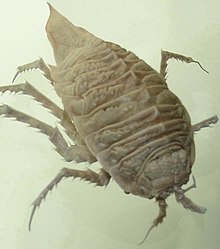| Revision as of 12:48, 10 April 2014 editJayen466 (talk | contribs)Autopatrolled, Extended confirmed users, Page movers, Mass message senders, Pending changes reviewers, Rollbackers56,627 edits add external image, expand info based on Held← Previous edit | Revision as of 10:51, 22 April 2014 edit undoCyclopia (talk | contribs)Autopatrolled, Extended confirmed users, Pending changes reviewers12,084 edits →Description: I cannot find this info in the referred sourceNext edit → | ||
| Line 23: | Line 23: | ||
| | image1 = of ''Glyptonotus antarcticus'' (]).<ref>{{cite web | url = http://photos.yale.edu/directory/dir_single_collection.php?collection_id=76 | title = Peabody Museum of Natural History, Division of Invertebrate Zoology Collections | publisher = ]}}</ref> | | image1 = of ''Glyptonotus antarcticus'' (]).<ref>{{cite web | url = http://photos.yale.edu/directory/dir_single_collection.php?collection_id=76 | title = Peabody Museum of Natural History, Division of Invertebrate Zoology Collections | publisher = ]}}</ref> | ||
| }} | }} | ||
| ''Glyptonotus antarcticus'' can grow to a maximum length of {{convert|9|cm|1|abbr=on}} |
''Glyptonotus antarcticus'' can grow to a maximum length of {{convert|9|cm|1|abbr=on}}<ref name=Held>{{cite journal |author=Held, Christoph; Wagele, Johann-Wolfgang |year=2005 |title=Cryptic speciation in the giant Antarctic isopod ''Glyptonotus antarcticus'' (Isopoda: Valvifera: Chaetiliidae) |journal=Scientia Marina |volume=69 |issue=suppl. 2 |pages=175–181 |url=http://epic.awi.de/14259/1/Hel2005j.pdf }}</ref> It has two pairs of compound eyes, a large pair on the dorsal surface and a smaller pair on the ventral surface. It is thought that the latter are useful when the animal is swimming, which it does in an upside-down position.<ref>{{cite journal |author=Meyer-Rochow, V. B. |year=1982 |title=The Divided Eye of the Isopod ''Glyptonotus antarcticus'': Effects of Unilateral Dark Adaptation and Temperature Elevation |journal=Proceedings of the Royal Society B |volume=215 |issue=1201 |pages=433–450 |doi=10.1098/rspb.1982.0052 }}</ref> With the exception of the eyes, certain mouthparts and feet, the whole surface of the animal has minute ] outgrowths of feathery hairs and knobbly scales. It is thought that these may help to prevent attachment of ] and marine larval organisms on the body surface.<ref>{{cite journal |author=Meyer-Rochow, V. B. |year=1980 |title=Cuticular surface structures in ''Glyptonotus antarcticus'' — a marine isopod from the Ross Sea (Antarctica) |journal=Zoomorphologie |volume=94 |issue=2 |pages=209–216 |doi=10.1007/BF01081935 }}</ref> | ||
| ==Distribution and habitat== | ==Distribution and habitat== | ||
Revision as of 10:51, 22 April 2014
| Glyptonotus antarcticus | |
|---|---|

| |
| Scientific classification | |
| Kingdom: | Animalia |
| Phylum: | Arthropoda |
| Class: | Malacostraca |
| Order: | Isopoda |
| Suborder: | Valvifera |
| Family: | Chaetiliidae |
| Genus: | Glyptonotus |
| Species: | G. antarcticus |
| Binomial name | |
| Glyptonotus antarcticus Eights, 1852 | |
Glyptonotus antarcticus is a benthic marine isopod crustacean in the suborder Valvifera. It was first described by James Eights in 1852 and the type locality is the South Shetland Islands.
Description
| External image | |
|---|---|
Glyptonotus antarcticus can grow to a maximum length of 9 cm (3.5 in) It has two pairs of compound eyes, a large pair on the dorsal surface and a smaller pair on the ventral surface. It is thought that the latter are useful when the animal is swimming, which it does in an upside-down position. With the exception of the eyes, certain mouthparts and feet, the whole surface of the animal has minute cuticular outgrowths of feathery hairs and knobbly scales. It is thought that these may help to prevent attachment of Foraminifera and marine larval organisms on the body surface.
Distribution and habitat
Glyptonotus antarcticus is native to the coasts of Antarctica, where it occurs in large numbers. It lives on the seabed at depths ranging from the intertidal zone down to about 580 m (1900 ft).
Biology
Glyptonotus antarcticus is a carnivore and scavenger and is often caught in baited traps on the seabed. It is an opportunistic predator with a mixed diet which includes a high proportion of echinoderms. That the available food supply may be fairly constant is shown by the fact that it breeds at any time of year.
Research
Given its abundance and the fact that it is relatively easy to keep in aquaria, Glyptonotus antarcticus has become an important model organism used as a research object in ecological, biochemical and physiological studies. A 2005 genetic study suggested that Glyptonotus antarcticus may in fact represent several distinct species.
References
- ^ Gary Poore; Marilyn Schotte (2012). Schotte M, Boyko CB, Bruce NL, Poore GC, Taiti S, Wilson GD (eds.). "Glyptonotus antarcticus". World Marine, Freshwater and Terrestrial Isopod Crustaceans database. World Register of Marine Species. Retrieved 2014-03-30.
{{cite web}}: CS1 maint: multiple names: authors list (link) - "Peabody Museum of Natural History, Division of Invertebrate Zoology Collections". Yale University.
- ^ Held, Christoph; Wagele, Johann-Wolfgang (2005). "Cryptic speciation in the giant Antarctic isopod Glyptonotus antarcticus (Isopoda: Valvifera: Chaetiliidae)" (PDF). Scientia Marina. 69 (suppl. 2): 175–181.
{{cite journal}}: CS1 maint: multiple names: authors list (link) - Meyer-Rochow, V. B. (1982). "The Divided Eye of the Isopod Glyptonotus antarcticus: Effects of Unilateral Dark Adaptation and Temperature Elevation". Proceedings of the Royal Society B. 215 (1201): 433–450. doi:10.1098/rspb.1982.0052.
- Meyer-Rochow, V. B. (1980). "Cuticular surface structures in Glyptonotus antarcticus — a marine isopod from the Ross Sea (Antarctica)". Zoomorphologie. 94 (2): 209–216. doi:10.1007/BF01081935.
- Clarke, A. (1979). "Assimilation efficiency of the Antarctic marine isopod Glyptonotus antarcticus". Marine Biology. 52 (2): 157–160. doi:10.1007/BF00390423.
- Leese, Florian; Mayer, Christoph; Held, Christoph (2008). "Isolation of microsatellites from unknown genomes using known genomes as enrichment templates" (PDF). Limnology and Oceanography: Methods. 6: 412–426.
{{cite journal}}: CS1 maint: multiple names: authors list (link) - Römisch, Karin; Matheson, Tom (2003). "Cell biology in the Antarctic: studying life in the freezer" (PDF). Nature Cell Biology. 4 (1): 3–5.
{{cite journal}}: CS1 maint: multiple names: authors list (link)